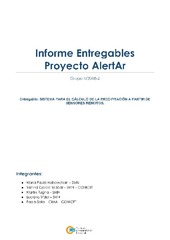Mostrar el registro sencillo del ítem
Sistema para el cálculo de la precipitación a partir de sensores remotos
| dc.contributor.author | Hobouchian, María Paula | |
| dc.contributor.author | García Skabar, Yanina | |
| dc.contributor.author | Rugna, Martín | |
| dc.contributor.author | Vidal, Luciano | |
| dc.contributor.author | Salio, Paola | |
| dc.date.accessioned | 2018-10-11T14:03:32Z | |
| dc.date.available | 2018-10-11T14:03:32Z | |
| dc.date.issued | 2018-02 | |
| dc.identifier.uri | http://hdl.handle.net/20.500.12160/806 | |
| dc.description | Informe del Proyecto AlertAr del Grupo II/2018-2 | es |
| dc.description.abstract | La técnica Hidroestimador para estimar la precipitación por satélite esta implementada en el Servicio Meteorológico Nacional (SMN) con distintas actualizaciones a partir de su versión original desarrollada en la National Oceanic and Atmospheric Administration (NOAA). La base de la técnica sostiene que las nubes producen precipitación en un determinado píxel si poseen topes más fríos que la media de los píxeles circundantes. A su vez, la precipitación se ajusta teniendo en cuenta principalmente la humedad del entorno. La versión del Hidroestimador previa a este trabajo, utilizaba los datos de temperatura de brillo del canal infrarrojo térmico centrado en 10.7 μm del satélite GOES-13 y los datos de humedad relativa y agua precipitable del modelo ETA de pronóstico numérico. A partir de 2018, la disponibilidad operativa de la información del satélite GOES-16 lanzado recientemente, sumado a la implementación del modelo WRF en un dominio que cubre toda la Argentina, permitieron realizar una actualización del Hidroestimador que incluyera ambos cambios en los datos utilizados por esta técnica. Actualmente, se están generando los mapas de precipitación instantánea con una resolución temporal de 15 minutos, y también los mapas de precipitación acumulada cada 6, 12 y 24 hs con una resolución espacial de 4 km. | es |
| dc.description.abstract | The Hydroestimator technique to estimate satellite precipitation is implemented at the National Meteorological Service (SMN) with different updates from its original version developed at the National Oceanic and Atmospheric Administration (NOAA). The basis of the technique assumes that clouds produce precipitation in a given pixel if they have colder tops than the average of the surrounding pixels. In turn, the precipitation is adjusted considering mainly the humidity of the environment. The previous version of the Hydroestimator used the data of brightness temperature of the thermal infrared channel centered on 10.7 μm of the GOES-13 satellite and the data of relative humidity and precipitable water of the ETA model of numerical forecast. Since 2018, the operational availability of recently launched GOES-16 satellite information, added to the implementation of the WRF model in a domain that covers all Argentina, allowed updating the Hydroestimator to include both changes in the data used by this technique. Currently, instantaneous precipitation maps are generated with a temporal resolution of 15 minutes, and also accumulated precipitation maps every 6, 12 and 24 hours with a spatial resolution of 4 km. | en |
| dc.language.iso | spa | es |
| dc.publisher | Servicio Meteorológico Nacional. Gerencia de Investigación, Desarrollo y Capacitación. Departamento de Investigación y Desarrollo. | es |
| dc.subject | HIDROESTIMADOR | es |
| dc.subject | NOAA | es |
| dc.subject | GOES-16 | es |
| dc.subject | WRF | es |
| dc.subject | PRECIPITACIÓN INSTANTÁNEA | es |
| dc.subject | PRECIPITACIÓN ACUMULADA | es |
| dc.title | Sistema para el cálculo de la precipitación a partir de sensores remotos | es |
| dc.type | Other | es |
